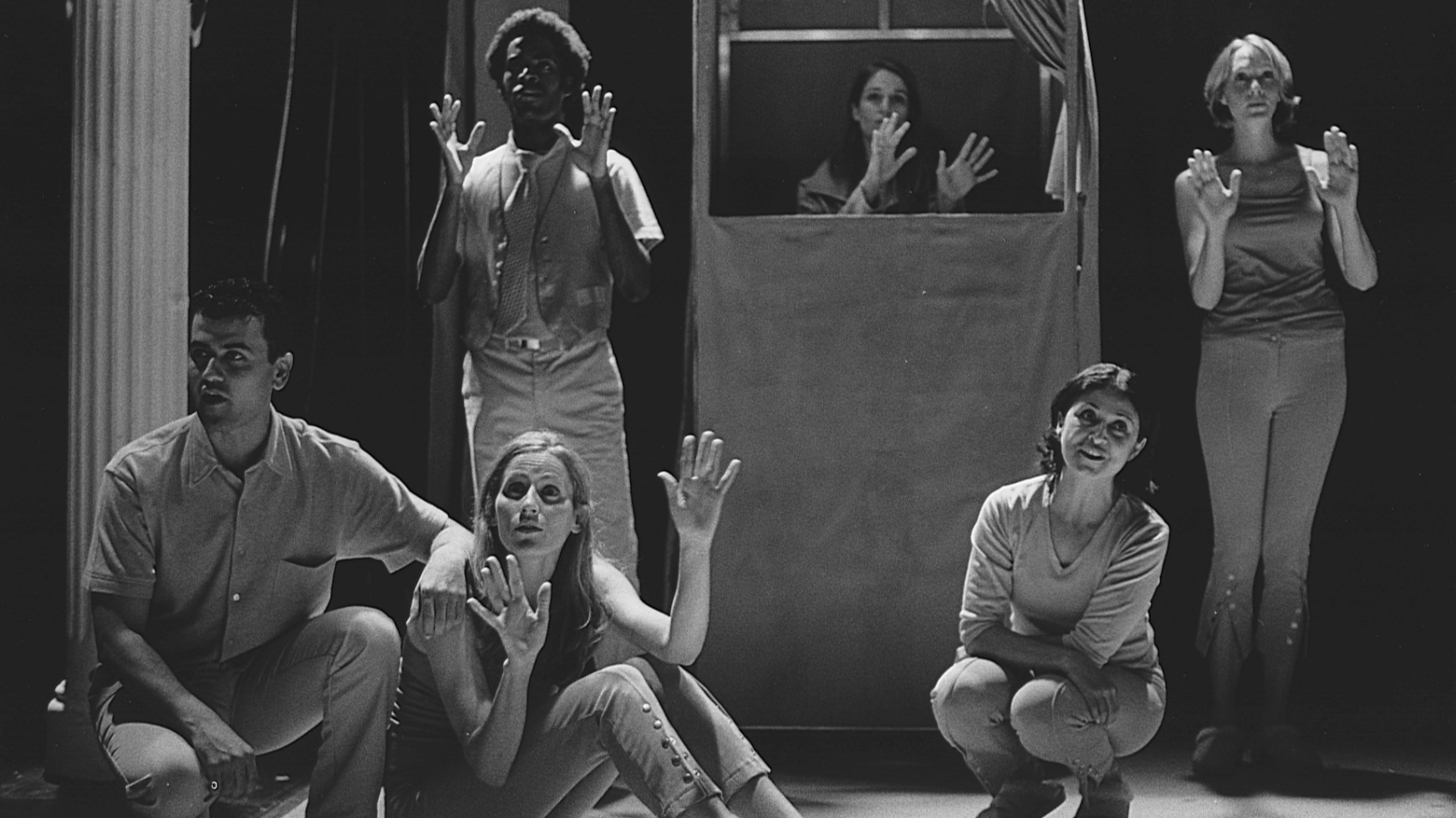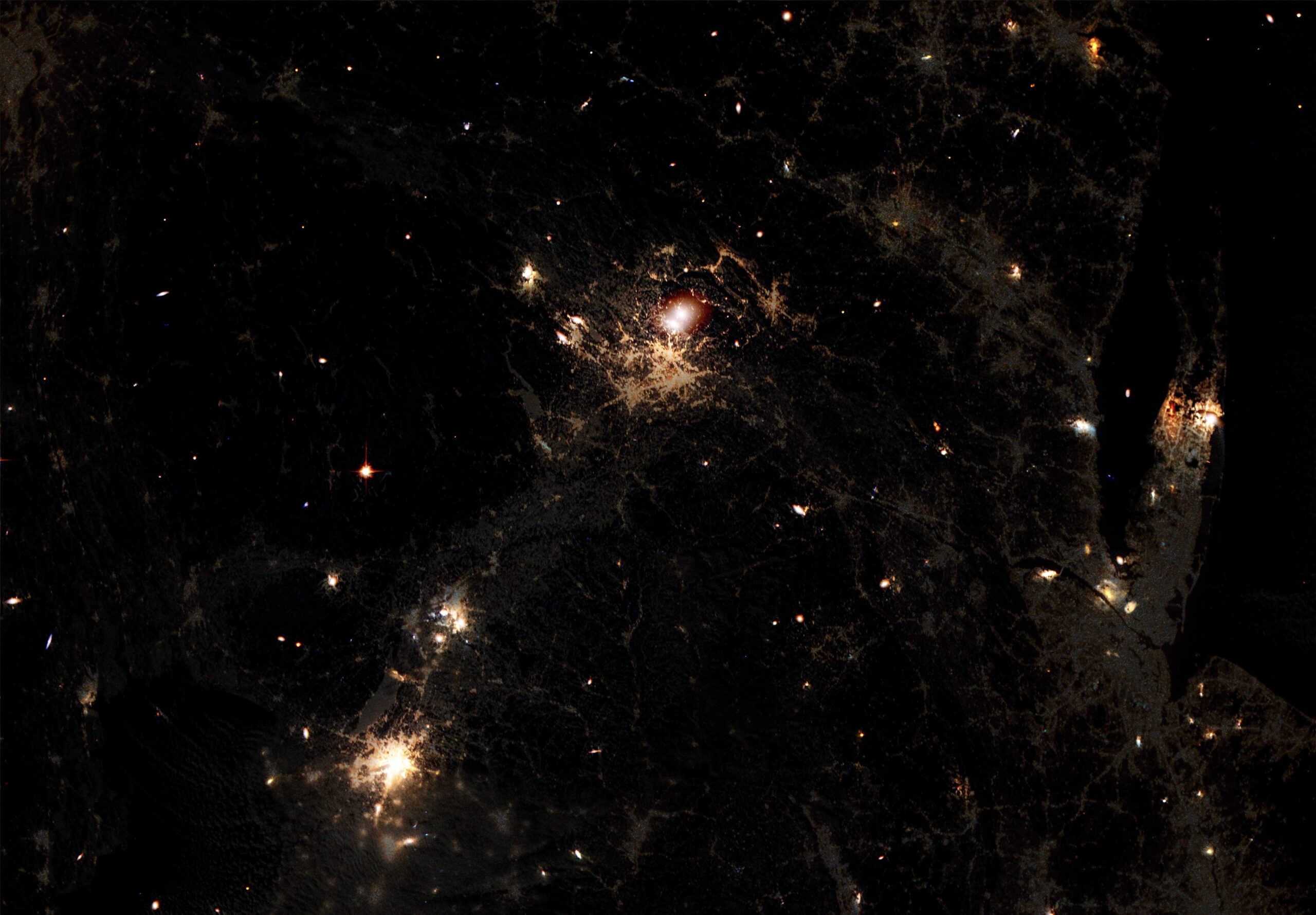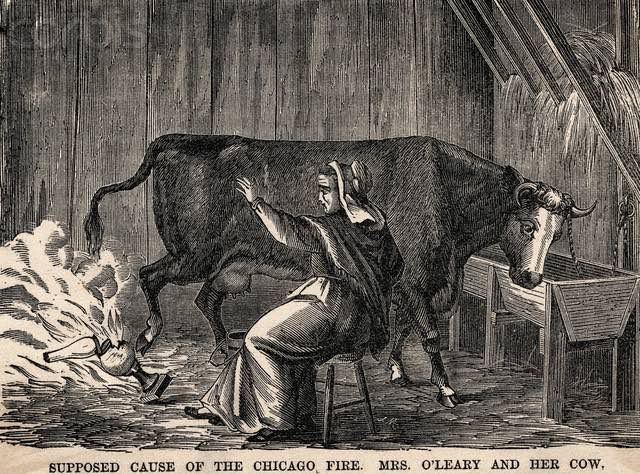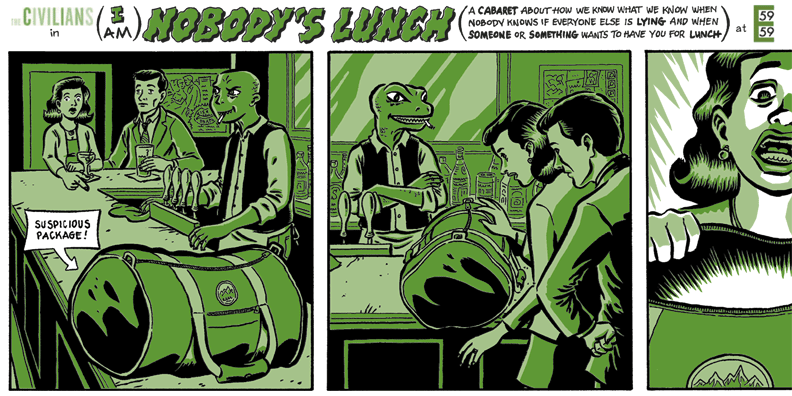At a time when interpersonal contact is limited, it sometimes feels like the most consistent relationships we can maintain are with our nightly news anchors. Chris Cuomo, Rachel Maddow, Anderson Cooper; they are always there at prime time, ready to please their captive audiences with tales of budget reconciliation, looming financial crisis, and turmoil within congressional committees. But what pulls us back nightly? Is it the compelling, perfectly-manicured messengers of the broadcasts, or the news itself, snippets of stories about the leaders who are supposed to be fighting for us?
In 2005, Civilians’ Artistic Director Steve Cosson, founding Associate Artist Michael Friedman and a company of actors* investigated the question of how we know what we know, resulting in (I Am) Nobody’s Lunch, a cabaret-play about the dissolution of consensus reality during the George W. Bush-era. Through eight songs, ranging from Beach Boys-reminiscent pop refrains to classic musical theatre torch anthems, Nobody’s Lunch composer/librettist Friedman explored how to make sense of the world and find the truth in a country that is complicated with lies and manipulation. Cosson, author of Nobody’s Lunch, took me track-by-track through the political cabaret—released in a world-premiere cast recording in August 2020—revealing Friedman’s musical inspirations, the process of converting found text into music, and the importance of shape-shifting lizards in American conspiracy theories.

Even though (Michael) travels through different genres in the show, there are these lyrical metaphors that connect and speak to each other.
Steve Cosson
Track #1: “The Telephone Song”
An ode to Bye Bye Birdie’s classic “Telephone Hour,” “The Telephone Song” is an amalgamation of fragmented interviews taken by the actor-devisers behind Nobody’s Lunch, with topics extending from theories about government tapes to Tom Cruise’s sexuality (this was 2005, remember). “Michael started this one pretty early in the process as an idea for an opening number,” says Cosson, “The idea was to use all these little pieces of the various interviews to set up the themes of the show and establish a twist on the interviewing process.” Development of the song went through multiple incarnations, with constant swapping of the texts in the spoken parts, but a theme that kept on reappearing was Americans’ relationship to the state and their romantic relationships to other people. “Even from the get-go it’s aspirational; it’s a yearning for that feeling of being in love with somebody and trusting them and believing in them,” Cosson explains further. That romantic sentiment can be felt in the breezy chorus, evocative of a Beach Boys hit, that expresses a universal craving for intimacy, “Don’t you want to be in love?/Don’t you want a love that’s true/Don’t you want to feel it’s true in your heart?” The solo sections, however, foreshadow that this love is in trouble—“That’s why I always end up staying in bad relationships. I can’t leave.” With “The Telephone Song,” the musical motifs heard throughout the rest of Nobody’s Lunch are established, remarks Cosson.“One brilliant thing about Michael and his lyrics is that even though he travels through different genres in the show there are these lyrical metaphors that connect and speak to each other. In ‘The Telephone Song,’ it’s ‘like a photograph that’s never quite developed,’ which is echoed later in ‘Schrodinger’s Cat.’”
Track #2: “Someone to Keep Me Warm”
“Before Michael wrote ‘Someone to Keep Me Warm,’ he said that he wanted to write a classic torch song,” says Cosson. Friedman took the premise of being wronged by a lover and sticking with them regardless, ran with it, and ended up writing about a masochistic relationship with authoritarianism. In “Someone to Keep Me Warm,” the speaker laments about the challenges of relationships and how, after all of that trouble, they, “Just want to sit back and be told/To be controlled/To be secure.” In different versions of Nobody’s Lunch the song has been sung by both a man and a woman, spinning the classic trope of the female-sung torch song on its head. Cosson elaborates, “The gender switch gives a little bit of alienation, that little bit of distance from it, that helps the audience to see in a sense how f***** up that musical trope is in general.”
Track #3: “It’s Scary How Easy It Is”
The Rosenbergs receiving life without parole, aliens giving people birth control; this song examines how easy it is to fall into conspiracy theories. “From all the interviewing that we did, a phrase that we heard over and over again was ‘I wouldn’t be surprised,’” says Cosson, “which seemed to really capture so much about Americans’ relationship to information, to authority, to experts, and to conspiracies. We felt like there was something pernicious about this phrase…that it speaks to both the distrust and doubt that seeped into the culture. But it’s a kind of passive doubt, a distrust that’s too cynical (or lazy) to try to ascertain actual facts. So, from this place of ‘I wouldn’t be surprised,’ one can both distrust everything and simultaneously be easily convinced of almost anything. Friedman made the tone of the song lighthearted to speak to the kind of comfort one feels when they submit to any and all conspiracy theories, Cosson believes, setting up a dynamic that is explored throughout the rest of the show.
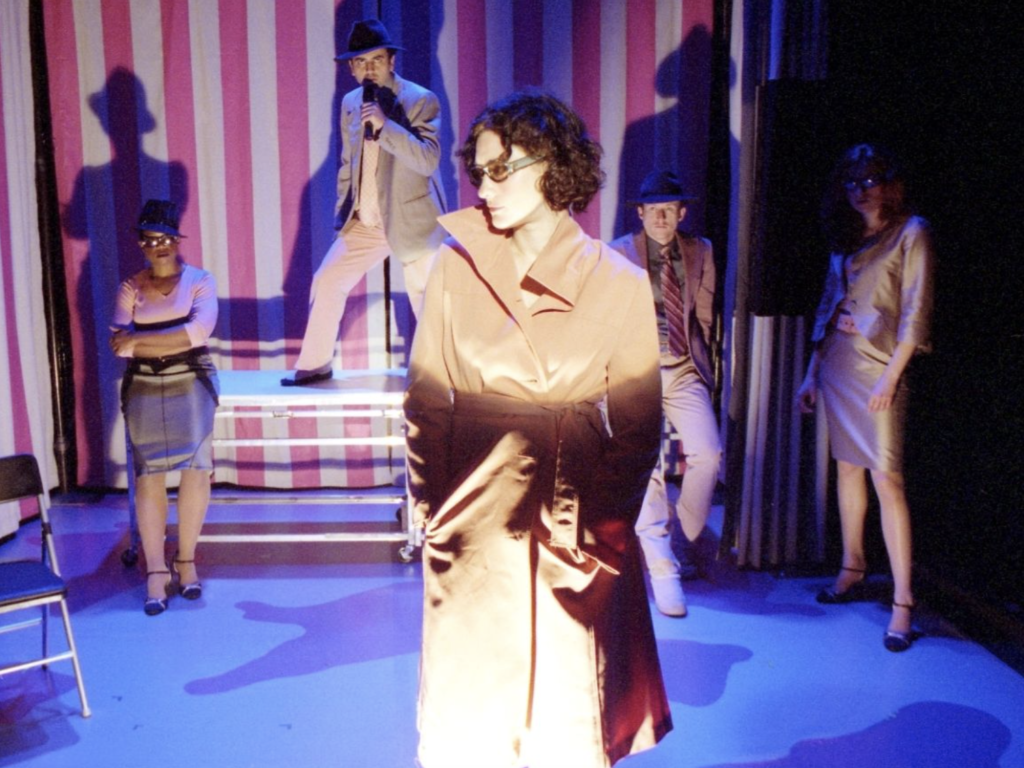
Track #4: “Watch Out Ladies”
According to Cosson, this song has a sort of “pentimento”— the presence of an earlier image or form that has been painted over. The seedlings for the song began when Cosson interviewed David Icke, an English conspiracy theorist, about a famous bloodline of shape-shifting lizards who control Earth. Icke’s interview didn’t make the cut, but led Cosson to Trance Formation of America: The True Life Story of a CIA Mind Control Slave by Cathy O’Brien, which is excerpted before “Watch Out Ladies.” In Trance Formation, O’Brien, who is supposedly a former MK Ultra sex slave under mind control from the CIA, details all of the world leaders she was trafficked to, including President Bush. She claims that Bush transformed into a lizard before her eyes. The lizard metaphor is carried into “Watch Out Ladies,” which is really about the Islamophobia that was so commonplace in post-9/11 America. James Bond theme songs also inspired the story: “In a way, I think Michael was doing something similar with what he did for ‘Someone to Keep Me Warm,’” says Cosson. “Taking something to an extreme and really kind of pushing the envelope to absurdity, but using genre to then spark the recognition that this racialized fear of the other is in fact deeply ingrained in mass culture. If you take most James Bond films they have built into them this imperialist racialized demonization of the other.”
Track #5: “Supersecret Places”
The title for this song comes from an actor-deviser interview that ended up being used in a completely different context. A teenage aspiring piercer was asked about her dreams. She revealed that she would like to be a body piercer and then points to her ear, “I did all of these myself. Yeah, I have four more. They’re in supersecret places.” That quote inspired an emotional reaction that in turn inspired “Supersecret Places,” which uses the aspiring piercer as a speaker as well as a male Special Ed assistant, who both sing of feeling lost and powerless, while yearning to find meaning.
“The Song of Progressive Disenchantment” ends in the most tragic place of all, with the speaker believing in nothing.
Track #6: “The Song of Progressive Disenchantment”
With “The Song of Progressive Disenchantment,” Friedman returns to the emotional center of the show, an epistemological crisis, or, in other words, a cultural meltdown provoked by the impossibility of knowing what’s true, expressed through a metaphor of a tortured romantic relationship. Equally inspired by Kurt Weill (Surabaya Johnny) and Greta Garbo in Anna Christie, the song, says Cosson, charts “what happens to a character that is actively trying to make sense of the world, to find the truth, to have agency in a world that is complicated by lies and misinformation and propaganda.” He adds, “Someone who came to see the first version of the show said it was like watching the whole country have a nervous breakdown—this is where the breakdown really happens.” With three large sections each broken up by long blocks of interview fragments, this 11 o’clock number became a company production, led with force on the cast album by the legendary Mary Testa. It ends in the most tragic place of all, with the speaker believing in nothing.
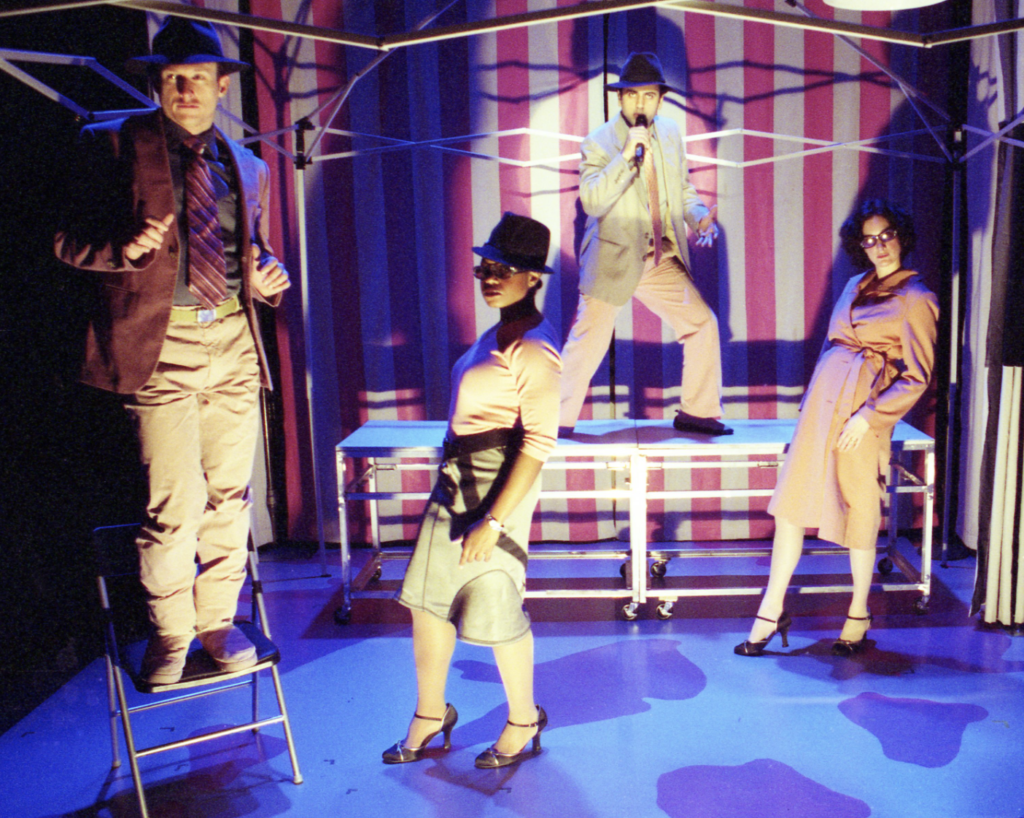
Track #7: “America”
Both “The Song of Progressive Disenchantment” and “America,” emerging from Friedman’s imagination rather than actor-deviser led interviews, “continue the meta story of the romantic relationship in relationship to the political,” says Cosson. “‘America’ is the song where that relationship actually becomes explicit.” In it, the narrator goes through milestone events in American history and culture, questioning why the country has never kept its grand promises: “You left me at the Berlin Wall/You left me watching Lucy Ball/You left me in the men’s room stall without warning.” Friedman consciously wanted to mix the geopolitical with the pop cultural, and struggled in figuring out where the destination of the song should be. Cosson explains that “he landed on the narrator waking up to the realization that she is in an abusive relationship. That’s where the ‘And now I see the cold clear light of the morning’ lyric comes in. At that point, the singer sees their full agency.”
Track #8: “Schrodinger’s Cat”
The last song in the show, and the last to be written, “Schrodinger’s Cat” uses the classic thought experiment to convey the complexities of the Bush era. “Michael had a couple of days of epic banging his head against the wall trying to figure out what the conclusion for this show should be. Endings are the hardest part,” acknowledges Cosson. “His breakthrough was landing on the Schrodinger’s Cat metaphor because he knew, we both knew, that we didn’t want to end with a decisive message song. It was something we talked about with this ending and a lot of endings for the shows that we wrote together. Mutually we were interested in complexity and contradiction. What we’re trying to do in the shows is actually work through these different stories and various conflicts—not to come to some singular conclusion but actually encourage the audience to see the complexity in the real world, maybe more clearly, or at least through the lens of this particular show. To be able to accept contradiction and still be able to take action. I think that’s why this song, the message of it, is kind of explicit—‘I know there is no total truth but I know that things are really bad.’ In the context of the politics we were talking about, the war built on propaganda and lies is definitely bad, that is a decisive thing.”
Michael had a couple of days of epic banging his head against the wall trying to figure out what the conclusion for this show should be.
Steve Cosson
In the Schrodinger’s Cat experiment, according to National Geographic, “A cat is placed in a steel box along with a Geiger counter, a vial of poison, a hammer, and a radioactive substance. When the radioactive substance decays, the Geiger detects it and triggers the hammer to release the poison, which subsequently kills the cat. The radioactive decay is a random process, and there is no way to predict when it will happen. Until the box is opened, an observer doesn’t know whether the cat is alive or dead… In other words, until the box was opened, the cat’s state is completely unknown and therefore, the cat is considered to be both alive and dead at the same time until it is observed.”
Friedman likened the experiment to the uncertainty many felt at the time, “In the moment before you open the box with the cat in it, there is this complexity and contradiction because it is both alive and dead,” says Cosson. “Of course, when you open the box you can decisively say what’s going on with the cat.” We are all susceptible to conspiracy theories, lies, and propaganda, the song emphasizes, but, ultimately, there is fact. In the final metaphor of the song, an interviewee is being gaslit by her landlord about mice. “When she finally says ‘I see poop, it’s right there,’ that is the moral directive of the play. We’re wanting to end the play with embracing complexity and contradiction but also saying within that, that when you see poop, you should say that there is poop and then do something about it.”
* Participants in the creation of (I Am) Nobody’s Lunch include Andy Boroson, Daoud Heidami, Christina Kirk, Alix Lambert, Matt Maher, Caitlin Miller and KJ Sanchez.
To learn more about The Civilians and to access exclusive discounts to shows, join our email list at TheCivilians.org.
Author
-

Caroline Meredith is the Editorial and Social Media Intern for The Civilians and a student at NYU's Gallatin School of Individualized Study (BA '22), where she is concentrating on arts administration and writing. She previously served as the editorial intern for American Theatre magazine and their publisher, Theatre Communications Group. As a general management intern, she assisted Martian Entertainment with "The Play That Goes Wrong" Off-Broadway and the 2019 Broadway transfer of "The Lightning Thief." At NYU, she was a producer of the 2020 Gallatin Arts Festival and a student editor and frequent contributor to Confluence, NYU Gallatin's online platform for student writing, art, and research.


